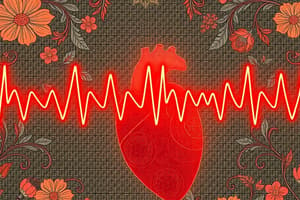Podcast
Questions and Answers
What is the primary action of quinine on the heart?
What is the primary action of quinine on the heart?
- Decrease automaticity (correct)
- Increase contractility
- Increase automaticity
- Increase excitability
What is the effect of quinidine on the heart?
What is the effect of quinidine on the heart?
- Depresses cardiac function (correct)
- Increases heart rate
- Decreases heart rate
- Increases contractility
What is the class of anti-arrhythmic drug that quinidine belongs to?
What is the class of anti-arrhythmic drug that quinidine belongs to?
- Class IV (Ca2+ channel blockers)
- Class III (K+ channel blockers)
- Class II (B-Adrenoceptor blockers)
- Class I (Na+ channel blockers) (correct)
What is the name of the prototype drug that is a B-Adrenoceptor blocker?
What is the name of the prototype drug that is a B-Adrenoceptor blocker?
What is the brand name of the drug Verapamil?
What is the brand name of the drug Verapamil?
What is the term for an abnormal cardiac rhythm?
What is the term for an abnormal cardiac rhythm?
What is the primary mechanism of action of quinidine?
What is the primary mechanism of action of quinidine?
What is the dominant effect of amiodarone on the cardiac action potential?
What is the dominant effect of amiodarone on the cardiac action potential?
What is the common side effect of quinidine?
What is the common side effect of quinidine?
What is the therapeutic use of quinidine?
What is the therapeutic use of quinidine?
What is the characteristic of amiodarone's structure?
What is the characteristic of amiodarone's structure?
What is the rate of absorption of quinidine after oral administration?
What is the rate of absorption of quinidine after oral administration?
What is the primary cause of symptoms in variant angina?
What is the primary cause of symptoms in variant angina?
Which type of drugs is commonly used to relieve variant angina?
Which type of drugs is commonly used to relieve variant angina?
What is the primary mechanism of action of nitroglycerine in relieving angina symptoms?
What is the primary mechanism of action of nitroglycerine in relieving angina symptoms?
What is the effect of nitroglycerine on myocardial oxygen demand?
What is the effect of nitroglycerine on myocardial oxygen demand?
What is the primary reason why nitroglycerine is administered sublingually or via a transdermal patch?
What is the primary reason why nitroglycerine is administered sublingually or via a transdermal patch?
What is the conversion pathway of nitroglycerine in relaxing vascular smooth muscle?
What is the conversion pathway of nitroglycerine in relaxing vascular smooth muscle?
Flashcards are hidden until you start studying
Study Notes
Quinidine's Cardiac Action
- Quinidine, an anti-arrhythmic drug, primarily prolongs the action potential duration in the heart, particularly affecting the ventricles.
- It belongs to Class IA anti-arrhythmic drugs.
Quinidine's Effects
- Quinidine's major effects include
- Prolonging the refractory period of the heart.
- Decreasing the excitability of the heart.
- Slowing down the conduction velocity.
- These effects are primarily achieved by blocking sodium channels.
B-Adrenoceptor Blocker
- Propranolol is the prototypical B-Adrenoceptor blocker.
Verapamil Brand Name
- Verapamil is available under the brand name Calan.
Abnormal Cardiac Rhythm
- The term for an abnormal cardiac rhythm is arrhythmia.
Amiodarone's Action Potential Impact
- Amiodarone predominantly prolongs the repolarization phase of the cardiac action potential, leading to a prolonged QT interval on the electrocardiogram (ECG).
Quinidine Side Effects
- A common side effect of quinidine is cinchonism, characterized by symptoms like tinnitus, headache, and visual disturbances.
Quinidine's Therapeutic Use
- Quinidine is used therapeutically to manage supraventricular and ventricular arrhythmias.
Amiodarone's Structure
- Amiodarone has a unique chemical structure that makes it lipophilic, facilitating its extensive tissue distribution, leading to long half-life.
Quinidine Absorption
- After oral administration, quinidine exhibits a relatively slow rate of absorption.
Variant Angina Symptoms
- Variant (Prinzmetal) angina symptoms arise primarily from coronary artery spasms.
Variant Angina Treatment
- Calcium channel blockers, such as verapamil or diltiazem, are commonly used to relieve variant angina.
Nitroglycerine Mechanism of Action
- Nitroglycerine relaxes vascular smooth muscle by converting to nitric oxide (NO) which activates guanylate cyclase, increasing cGMP levels and ultimately relaxing smooth muscle.
Nitroglycerine's Impact on Myocardial Oxygen Demand
- Nitroglycerine reduces myocardial oxygen demand, primarily through its vasodilatory effects.
Nitroglycerine Administration
- Nitroglycerine is administered sublingually or via a transdermal patch to bypass first-pass metabolism in the liver and achieve rapid, sustained onset of action.
Studying That Suits You
Use AI to generate personalized quizzes and flashcards to suit your learning preferences.




